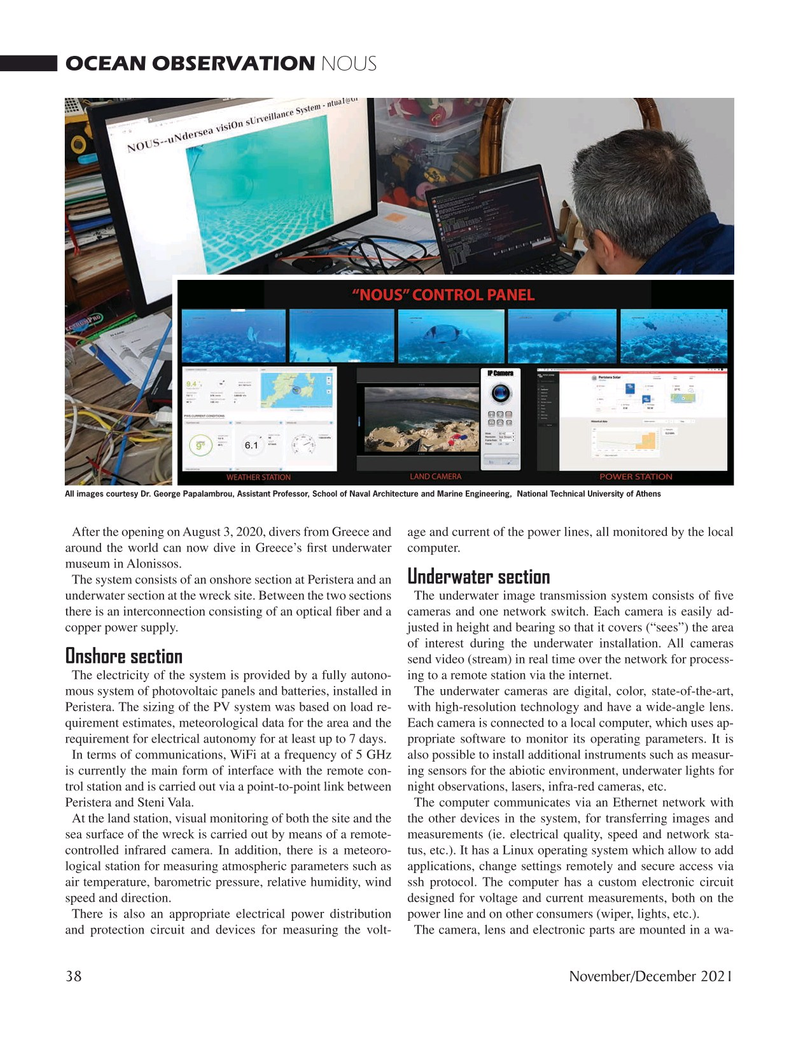
Page 38: of Marine Technology Magazine (November 2021)
Ocean Observation: Gliders, Buoys & Sub-Surface Networks
Read this page in Pdf, Flash or Html5 edition of November 2021 Marine Technology Magazine
OCEAN OBSERVATION NOUS
All images courtesy Dr. George Papalambrou, Assistant Professor, School of Naval Architecture and Marine Engineering, National Technical University of Athens
After the opening on August 3, 2020, divers from Greece and age and current of the power lines, all monitored by the local around the world can now dive in Greece’s ? rst underwater computer.
museum in Alonissos.
The system consists of an onshore section at Peristera and an Underwater section underwater section at the wreck site. Between the two sections The underwater image transmission system consists of ? ve there is an interconnection consisting of an optical ? ber and a cameras and one network switch. Each camera is easily ad- copper power supply. justed in height and bearing so that it covers (“sees”) the area of interest during the underwater installation. All cameras
Onshore section send video (stream) in real time over the network for process-
The electricity of the system is provided by a fully autono- ing to a remote station via the internet.
mous system of photovoltaic panels and batteries, installed in The underwater cameras are digital, color, state-of-the-art,
Peristera. The sizing of the PV system was based on load re- with high-resolution technology and have a wide-angle lens. quirement estimates, meteorological data for the area and the Each camera is connected to a local computer, which uses ap- requirement for electrical autonomy for at least up to 7 days. propriate software to monitor its operating parameters. It is
In terms of communications, WiFi at a frequency of 5 GHz also possible to install additional instruments such as measur- is currently the main form of interface with the remote con- ing sensors for the abiotic environment, underwater lights for trol station and is carried out via a point-to-point link between night observations, lasers, infra-red cameras, etc.
Peristera and Steni Vala. The computer communicates via an Ethernet network with
At the land station, visual monitoring of both the site and the the other devices in the system, for transferring images and sea surface of the wreck is carried out by means of a remote- measurements (ie. electrical quality, speed and network sta- controlled infrared camera. In addition, there is a meteoro- tus, etc.). It has a Linux operating system which allow to add logical station for measuring atmospheric parameters such as applications, change settings remotely and secure access via air temperature, barometric pressure, relative humidity, wind ssh protocol. The computer has a custom electronic circuit speed and direction. designed for voltage and current measurements, both on the
There is also an appropriate electrical power distribution power line and on other consumers (wiper, lights, etc.).
and protection circuit and devices for measuring the volt- The camera, lens and electronic parts are mounted in a wa- 38 November/December 2021
MTR #8 (34-49).indd 38 11/22/2021 12:59:20 PM

 37
37

 39
39
